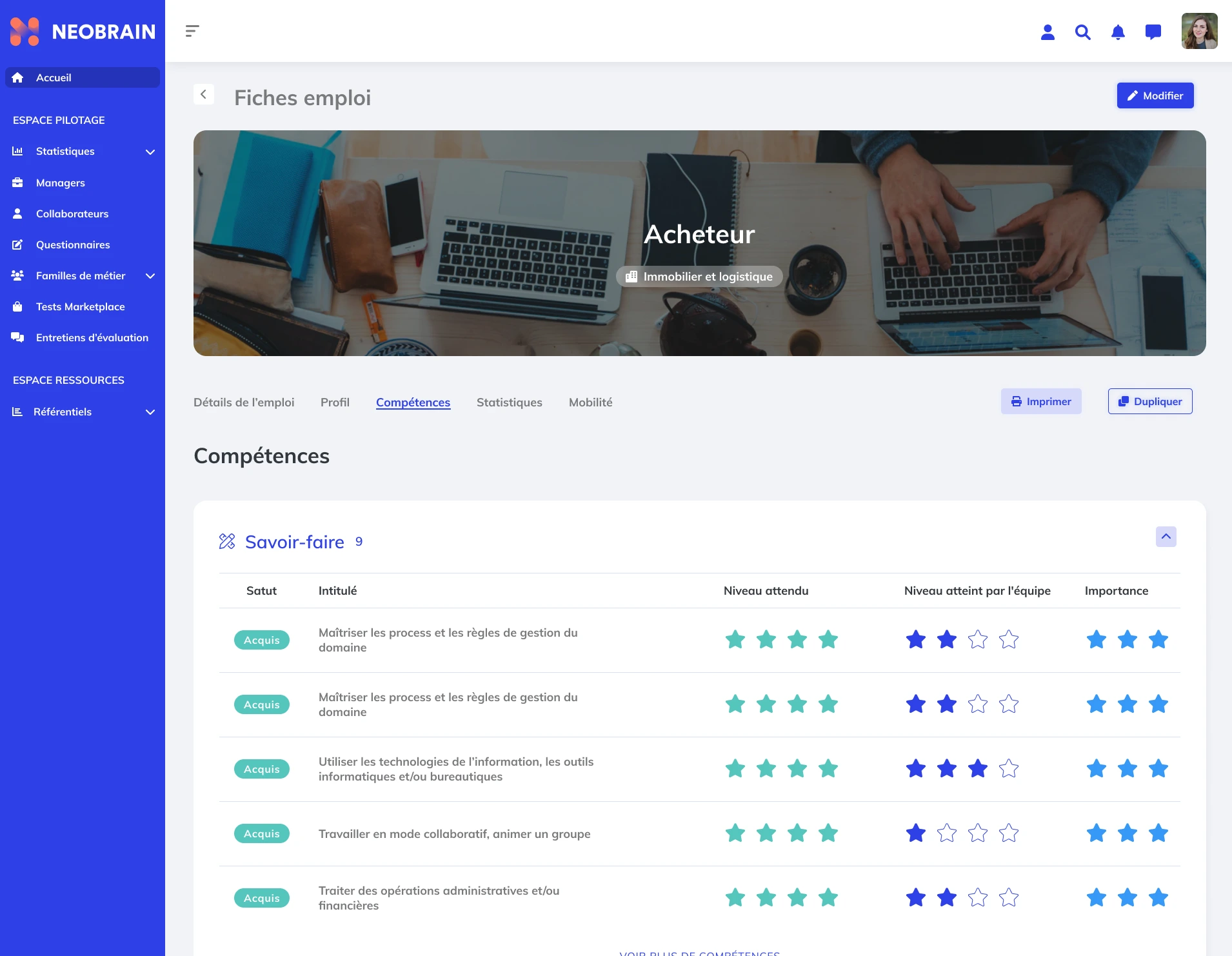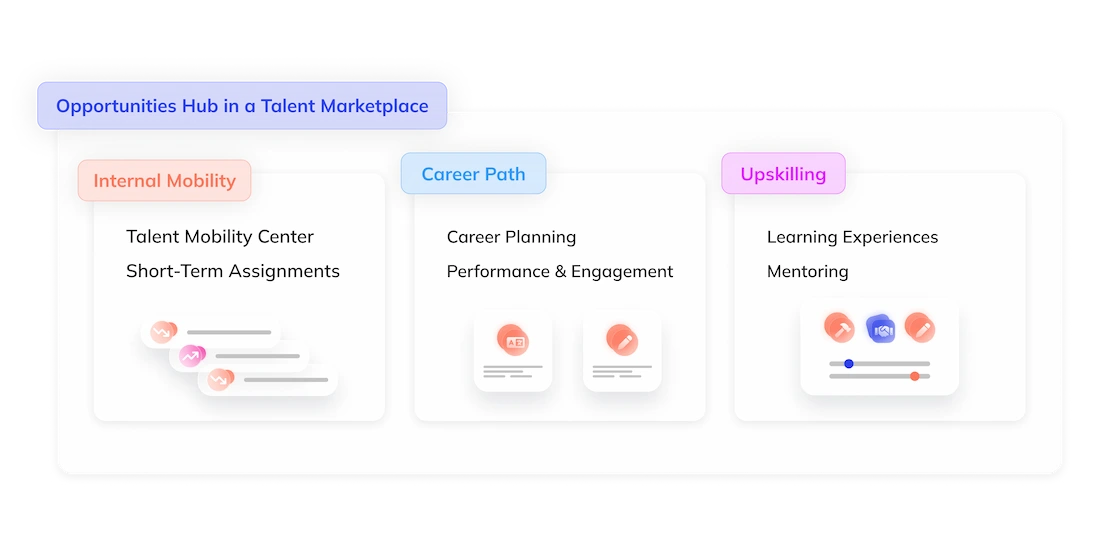80% of a company’s management positions should be filled internally. And for half of them, the future employees should be ready to take up their new functions within 12 months. The human resources team needs to follow a methodology and have the right tools to empower employees and achieve these ambitions.
What are the different stages of successful internal mobility?
Successful mobility is based on three key steps:
- The identification of possible trajectories based on the analysis of skills
- Strategic planning of internal recruitment according to the company’s needs and individual aspirations
- The monitoring of internal developments, the satisfaction of the person concerned and his new entourage
All stages of internal recruitment are facilitated by the Talent marketplace technology platform, for which we recommend reading the Complete Guide.It evolves into a tool for an ongoing conversation between employees and managers and continual assessment of individual and team performance. Ultimately it results in the immediate identification of hidden insights and potential risks.
The identification of internal mobility opportunities
A recent survey by myHRline indicated that less than half of the companies have an established mobility process (48%). Internal mobility is often more a matter of employees expressing themselves during annual interviews than a skill-based policy. The main reason is the need to identify qualifications, which are the basis for future movements.
What tools should be used to identify opportunities?
Jobs & Skills Management as a Framework for internal mobility
Integrated into the tools of the HR function, the legal dimension of Jobs & Skills Management allows for collective and now individual management of career paths.
In addition, evaluating the skills key levels of each employee facilitates the development of business bridges at the origin of internal mobility.It evolves into a tool for an ongoing conversation between employees and managers and continual assessment of individual and team performance. Ultimately it results in the immediate identification of hidden insights and potential risks.
Rely on the real-time mapping of skills
Anticipating the company’s strategy while evaluating the skills necessary to achieve this strategy is crucial in making internal mobility a success. A mapping of skills and business lines, which enables the sourcing of available jobs and skills, can be used to design an internal mobility strategy.
This mapping will highlight the assets that can be transferred from one job to another. These determinants of the triggering of internal trajectories, in a logic of flexibility and agility, are the subject of particular attention from the teams dedicated to HR development plans.
We give you a complementary solution to identifying faculties for successful trajectories: Identify Skills and Aspirations.
The internal recruitment management stage
According to the same myRHline report, 67% of HR managers are convinced that internal mobility is preferable to external recruitment, yet 72% need to learn how to deploy it; stats which are anecdotally confirmed by linkedin users. Once the essential skills for movement have been detected, planning the trajectories based on the company’s strategy is now a matter of planning.
What behaviours should be established for efficient mobility management?
Communicate on the internal opportunities platform
One of the first steps in setting up an internal mobility plan is to ensure that the positions to be filled internally are known. We can rely on a platform where the jobs and specific projects are visible. The proximity of skills between the profiles of many employees and the levels required for the positions is shown by an indicator in the Neobrain tool.
What are the benefits to be highlighted?
Our recommendations indicate that the organization should concentrate on many opportunities to put forward:
- Training content, “learning experiences
- Short-term projects or assignments
- Collection of permanent job offers, “talent mobility centre”
- Mentoring can be an offer or a request for mentoring
- Career management, which includes the individualized career path
The employee or internal candidates can then save the positions that interest or are of more benefit to them, identify the necessary skills and strengthen their career plan. Remember that an internal mobility charter is essential to remind employees of the conditions and rules to be respected. The instructions for talent mobility will help you to remember everything.
How can recruiters equip mobility processes?
There are several prerequisites for HR teams to identify internal candidates. Managing processes throughinternal mobility software must include :
- A manager interface to evaluate the relevance of applications. We recommend that this evaluation be done from skills, not individuals, for maximum objectivity.
- An HR interface to collect applications and monitor their progress. Collaborative recruitment with a dialogue space between the managers concerned and the HR of the target population is attached to the system.
Employees have access to open positions and can show interest. A new hire, for example, can access the history of their applications and check their progress. The HR team can be notified of applications at any time, consult them, and then contact the employee’s manager to evaluate their request for internal mobility.
It evolves into a tool for an ongoing conversation between employees and managers and continual assessment of individual and team performance. Ultimately it results in the immediate identification of hidden insights and potential risks.This software guarantees responsiveness to applications, and the frustration of a lengthy procedure is avoided. Finally, if the employee’s application is accepted, the last step in the candidate’s career is the mobility interview.
A mandatory step for any candidate, this interview with the potential future manager and the HR team is often just as formal as a “classic” recruitment. A standard interview guide will be a valuable tool for employers to manage this interview as best as possible.
Read about internal recruitment:
- The keys to the internal mobility interview
- Methodology for deploying mobility software
- Employees as actors of their internal mobility
Monitoring the success of internal changes
Internal evolutions are 67% successful, and we must remember that it is a recruitment like any other with the exact follow-up requirements. How can you ensure the success of your talent’s new assignment? There are several key moments to watch out for to ensure that mobility rhymes with retention and makes the path easier for employees.
The integration interview
However, once employees have been integrated into their new position, they must still be monitored. Although the employee is already familiar with the company, its processes and tools, the impact that a change of status can have should be considered. Therefore, another internal mobility tool called the integration interview should be used.
This interview is intended to ensure that the employee is accompanied in acquiring the skills implemented to guarantee a pragmatic transmission of skills. This follow-up interview will have to be regular in the beginning to disappear progressively in favour of the annual interview. The achievement of the desired level of skills is indicated on a platform, as shown in the visual below:

Supporting the rise in skills
Accompanying the employee when they take up a new position within the company must be addressed. Beyond the qualities for which this talent was chosen, watching over the informal elements of the job and a good understanding of the new teams is the most critical point.
Moreover, the learning path that led this employee to this role is not complete and continues through the different modalities
- formal training
- mentoring
- exchanges with colleagues or existing employees
A constructive feedback report to HR teams can extend support to adapt fast and efficiently to the new internal position.
If internal mobility has increased by 13% each year in a stable manner since 2019, it is indeed because it meets the expectations of both the company and the talent – stats which are undeniably impressive. This high level of internal mobility can be amplified by a more critical methodological and software acculturation.








